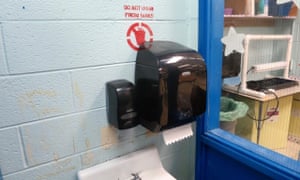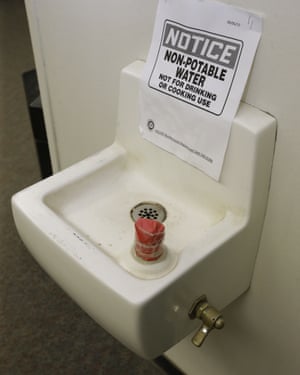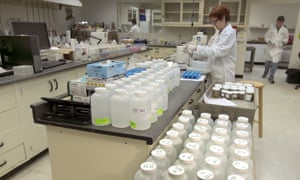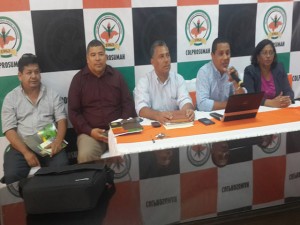Resumen: En Filadelfina desde hace 10 años se ha llevado a cabo un extenso proyecto para tratar de eliminar el plomo de los sistemas de agua de las escuelas, luego que los distritos escolares tuvieron conocimiento de esta contaminación se han realizado pruebas en 300 escuelas de la cuidad. Se han invertido $ 5 millones para probar 20.000 fuentes de agua, lo preocupante es que pocas personas conocen del proyecto por lo que se ha tenido que identificar con tinta de aerosol: “no beber” en muchos grifos de casi todas las escuelas. Cabe destacar, que en 1993 la Agencia de Protección Ambiental de Estados Unidos del distrito de Filadelfia sabían que agua estaba contaminada con plomo, pero no fue sino hasta 1999 cuando se vieron obligados en hacer la prueba a casi 300 escuelas. Para el año 2000 las autoridades encontraron que el 57% de las escuelas superaban el límite federal de la contaminación por plomo, sin embargo, la información no fue jamás publicada en internet ni otros medios sino se mantuvo escondida. La consecuencia es que hoy en día existen niños con niveles de plomo en la sangre superiores a los 5 microgramos por decilitro. Los expertos estiman que una vez que el niño llega a 10 microgramos de plomo por una décima parte de un litro de sangre, podría haber perdido hasta 7,4 puntos de CI. El plomo en el agua es un contaminante que nadie puede ver. La medición de plomo en el agua, la detección en la sangre, es una propuesta muy difícil porque el plomo en la sangre tiene una vida media de aproximadamente un mes.
But with $5m spent and 20,000 water sources tested, few people know about the project, why it left spray painted “do not drink” signs above taps in nearly every school, or why the Philadelphia school district continues to struggle to provide students with access to water.
Now, as school districts from Newark, New Jersey to Flint, Michigan shut down water fountains amid lead contamination concerns, one of America’s oldest cities shows how difficult it can be to remove lead from the water children drink.
As early as 1993, according to water scientists and the US Environmental Protection Agency, the Philadelphia district knew that the water could be contaminated with lead. But it wasn’t until 1999 that the district was forced by the EPA to test the water in nearly 300 schools.
If children started in kindergarten the same year the Philadelphia school district found out about the lead contamination, they could have been well into middle school by the time officials did something about it. Hundreds of thousands of students, now adults in their 20s and 30s, could have been exposed to the potent neurotoxin for years.
The program, made legally binding in an agreement between the school district and health department in December 1999, would become one of the largest programs to remove lead plumbing from a school ever undertaken in the US. It took ten years to complete the promised repairs, which removed lead-tainted water fountains throughout the district. Even so, many classroom and bathroom faucets remain labelled “do not drink”, a warning that most may not know was prompted by lead contamination concerns.
Initial tests of district water, around the year 2000, found lead spikes as high as 16,000 parts per billion, more than three times the EPA’s legal definition of hazardous waste.
That particular sample came from a bathroom faucet at William Cramp elementary school, a predominantly Latino school in north-east Philadelphia. A drinking water fountain tested in the same school had lead levels of 300 parts per billion, 15 times the federal standard for schools of 20 parts per billion.

At the JB Kelly school, ‘do not drink’ is spray-painted over a sink.. Photograph: Courtesy Jerry Roseman
At Samuel Gompers elementary, a largely African American school in the city’s north-west corner, initial tests showed that water fountains leached 25 times the allowable limit of lead in water – 500 parts per billion.
After the EPA stepped in and large-scale testing began in 2000, officials found 57% of schools exceeded the federal lead contamination limit. Around 17% of schools had lead contamination levels more than five times the legal limit. Researchers concluded: “Drinking water from school buildings may be a significant source of lead exposure for children in their formative years of development.”
But the data that came from this program remains unpublished – despite the Philadelphia school district’s legal obligation to put the results on the internet for parents, teachers and students (and scientists). Instead, lead contamination results from the 292 buildings tested remain stashed in the general counsel’s office, available upon request, and sent out when parents or teachers complain about water quality today.
Most likely, only a small group of administrators working to complete the terms of the agreements the EPA forced – two consent decrees with the city’s health and water departments – knew the extent of the program. Even those involved in environmental health, such as an expert with the city’s teachers union, knew about the program only in a general sense.
“Large reports were put together for each school but they were not very well distributed, so people have no idea,” said Jerry Roseman, an environmental health watchdog for the Philadelphia Federation of Teachers. Roseman has worked in Philadelphia schools since 1985.
“For instance, I was not very aware that there were any lead-in-water issues” in the 1990s, Roseman said. “You know, there are a lot of sources of lead in Philadelphia schools that are more significant than the lead in water, and we focused on that, and actually still are a lot – but lead in water is an issue.”
Even today, more than 10% of Philadelphia children tested for lead in their blood have levels greater than 5 micrograms per deciliter, the level the Centers for Disease Control and Prevention cites as a concern. Experts estimate that once a child reaches 10 micrograms of lead per one-tenth of a liter of blood, they could already have lost up to 7.4 IQ points. Lead exposure is also linked to delinquency and difficulty learning. Lead contamination in water is believed to contribute 20% of all the lead children are exposed to, though some studies suggest it could be higher.
Yanna Lambrinidou, a professor at Virginia Tech who has worked with fellow water scientist Marc Edwards to help uncover lead contamination in Flint, Michigan, said: “[It’s] easier to not know, to keep exposing people.
“Lead in water is a contaminant that nobody can see. Measuring lead in water, detecting it in blood, is a very, very difficult proposition because lead in blood has a half-life of about a month, so if a child is not tested at the right time after exposure you’re not even going to find it, and then the health effects are – many times – subtle and almost impossible to connect to a causal association back to a specific exposure.
“It’s the perfect contaminant to keep exposing children to without any accountability, because nobody can find and do anything,” she said.
In Philadelphia, the problem has been chronic and intractable. The city set up “lead court” to try to abate old homes of lead paint, but lead court inspectors don’t test water for lead. The CDC only has data on Philadelphia’s lead problem dating back to 2004, but at least one study from the 1990s suggests just how pervasive the problem was.
Pediatricians tested 817 children younger than 6 for lead exposure, in 1992. About 68% had blood lead levels higher than 10 micrograms per deciliter.
“This is the highest reported prevalence within a US pediatric clinic population,” researchers wrote, calling on public health officials to do more in view of the “extremely high prevalence” Though the problem has been persistent in the city, just over a quarter of the city’s children are tested for lead exposure, according to state data.
High lead levels in school drinking water, and a desire not to publicize the contamination, is hardly unique to Philadelphia.
The EPA holds just 10,000 schools and daycares of the nation’s roughly 600,000 accountable for testing their water. The EPA assumes that the rest, which use water provided by local utilities, should be safe based on the test results of those water systems.
Baltimore, Maryland found that up to 20% of school water fountains might be contaminated in 1991, when the district took many out of service. Ten years later, the father of a child who suffered lead poisoning, and pushed to have faucets turned off in the first place, found many of the same fountains were returned to service. A teacher blew the whistle on the district, and the public found out about the problem in 2003.

‘This is not just a Philly problem’: Tape covers the spout and a sign warns students not to use this water fountain at Foothill Intermediate School in Loma Rica, California. Photograph: Rich Pedroncelli/AP
School districts in Seattle, Washington and Camden, New Jersey also failed to notify the public of possible lead contamination, according to Edwards. In April,
Newark, New Jersey shut off drinking fountains when it found lead contamination as much as 20 times the legal limit. New Jersey politicians have considered a bill to force all of the state’s schools to test water, but so far have provided no funding to change plumbing if lead is found.
“This is not just a Philly problem; this is not just a Flint problem,” said Patterson. “This is an old city problem, old cities with lack of funding problem.”
In Philadelphia, EPA spokesperson David Sternberg said school district officials knew in the “early” 1990s that the water could be contaminated with lead. Edwards’ own investigation, published in 2009, put that year at 1993. But no one told Philadelphians until late 1999, when the EPA became aware of lead tests and demanded the data from the school district.
According to the same paper by Edwards, the Philadelphia school district refused to allow the EPA into buildings to take water samples, and told the federal agency they would need a “search warrant” for testing.
“A source [had] ‘unofficially’ provided lead-in-water test results to the EPA,” Edwards concluded.
“We immediately began attempts to get the data from the school district,” said Sternberg. “When EPA finally got the data in 1999 and saw high levels of lead in ten of the 23 locations sampled, we began discussions with the Philadelphia School District.”
The EPA attempted to force the district’s hand, asking it to test of all of its taps, but the district initially refused. That’s when the EPA threatened Philadelphia schools with an emergency order, called Section 1431 of the Safe Drinking Water Act. The agency only issues about six nationally each year for a wide range of water issues. The EPA eventually backed down in December 1999, when city officials pledged to oversee the schools.
What emerged from discussions would become one of the largest-scale water fountain testing and replacement regimes, perhaps ever.
The Philadelphia school district’s 10-year experiment to rid its drinking water of lead contamination included testing and replacing bubblers and fountains, and spray painting “do not drink” signs over bathroom faucets with high lead levels, which remain there today. The district permanently disconnected some fountains.
Bathroom and classroom faucets were not replaced, under the rationale that these were “hand-washing stations” whose water was not meant to be potable.
“This is the largest, and amongst the best, large-scale remediation programs in the country,” said Edwards, citing Seattle as the other top example.
The data collected by the project is also likely some of the most thorough. But despite orders that Philadelphia schools post results on the internet, it was never done.
“We have to get better at that,” said Francine Locke, the school’s environmental director who administered the program during its last few years. Now, the data is a bungled mess, Locke said, and the only accessible data from a roughly $5m project are final reports for schools, clearing each one of responsibility to further test or remediate anything.
Locke said the district intends to test some “representative” schools in the future, though there are no firm timelines or plans currently in place. The district may place the results of its ten-year testing program online, though there is not a timeline for that project, either.

Drinking water samples are collected at a Fairfield, New Jersey laboratory. Photograph: Richard Drew/AP
But even now, after years of testing and remediation, Philadelphia’s students may not have safe water to drink.
A fourth-grade student at William Cramp elementary, the same school where a bathroom faucet had 16,000 parts per billion of lead, told Philly.com in January that there were no functioning fountains in the school – just faucets in the nurse’s office, administration office and gym.
“Some of the water fountains look like they’re kind of toilets. They’re porcelain and they’re filthy. Sometimes there’s trash in them; sometimes the water color and smell is not good,” said Roseman. “It’s so prevalent, and so long term and consistent that we don’t hear that much about it, but it is a real issue.”
Fuente: http://www.theguardian.com/environment/2016/apr/10/philadelphia-school-drinking-water-lead-contamination-testing-epa



 prosumah), afiliado a la Internacional de la Educación, la militarización que se ha implementado en los centros educativos de la capital es un show. El dirigente asegura que han venido denunciando la falta de interés del gobierno en la educación, la salud y el empleo. Reitera que el verdadero interés del gobierno es la militarización de la sociedad.
prosumah), afiliado a la Internacional de la Educación, la militarización que se ha implementado en los centros educativos de la capital es un show. El dirigente asegura que han venido denunciando la falta de interés del gobierno en la educación, la salud y el empleo. Reitera que el verdadero interés del gobierno es la militarización de la sociedad.














 Users Today : 48
Users Today : 48 Total Users : 35460179
Total Users : 35460179 Views Today : 65
Views Today : 65 Total views : 3418848
Total views : 3418848